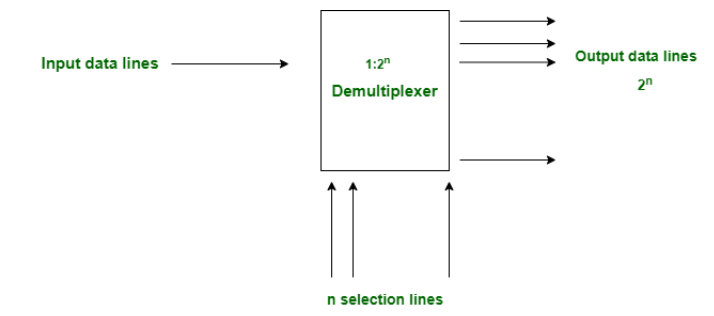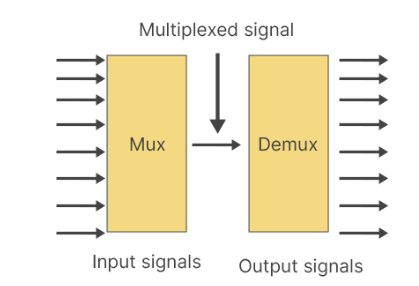OUTLINE:
Multiplexer & Demultiplexer
 376
376Multiplexer
An analog multiplexer is an electronic device that allows multiple analog signals to be transmitted on a single channel or bus. It works by selecting one of several input channels and routing the selected signal to the output, based on a control signal.
The input signals are typically voltage or current signals, and the output signal is also a voltage or current signal, which is a combination of the selected input signal and any noise that may be present in the system.
Analog multiplexers can have various configurations, including single-ended or differential inputs, and single-ended or differential outputs. The number of input channels and the range of voltages or currents that can be handled depend on the specific design of the multiplexer.
In telecommunications, analog multiplexers are used to transmit multiple voice signals over a single communication link. They enable efficient use of transmission bandwidth, reducing cost and complexity. In data acquisition systems, they allow for the collection of multiple sensor readings using a single data acquisition card or module.
Analog multiplexers can be implemented using different technologies, including CMOS, TTL, or BiCMOS. Some multiplexers can include additional features such as built-in amplifiers, filters, or voltage regulation circuits to enhance their functionality.

Demultiplexer
A demultiplexer, or demux for short, is the opposite of a multiplexer. It is an electronic device that takes a single input and distributes it among several output channels based on a control signal. A demux essentially performs the inverse operation of a mux.
In analog systems, a demultiplexer receives a single analog signal at its input and then routes it to one of several output channels based on a binary control signal. The output channels may be connected to other devices such as amplifiers, filters, or data acquisition systems.
Like multiplexers, demultiplexers can be implemented using various technologies including TTL, CMOS, or BiCMOS. Demuxes can also have different numbers of output channels, ranging from 2 to 16 or more, depending on the specific design of the demultiplexer.
Demultiplexers are commonly used in many applications, including telecommunications, audio/video processing, and instrumentation. For example, in multimedia systems, a demux can separate the audio and video components of a composite video signal, routing each component to the appropriate output channel.
A demultiplexer is a critical component of an overall system design because it enables efficient use of resources by allowing multiple output channels to share a single input channel.


|
Multiplexer |
Demultiplexer |
|
Multiplexer processes the digital information from various sources into a single source. |
Demultiplexer receives digital information from a single source and converts it into several sources |
|
It is known as Data Selector |
It is known as Data Distributor |
|
Multiplexer is a digital switch |
Demultiplexer is a digital circuit |
|
It follows combinational logic type |
It also follows combinational logic type |
|
It has 2^n input data lines |
It has single data input |
|
It has a single data output |
It has 2^n output data lines |
|
It works on many to one operational principle |
It works on one to many operational principle |
|
In time division Multiplexing, multiplexer is used at the transmitter end. |
In time division Multiplexing, demultiplexer is used at the receiver end. |
Related Product: https://www.chipsmall.com/Post/info/texas-cd74hc4067m96-analog-multiplexer-demultiplexer.html

Disclaimer: The views and opinions expressed by individual authors or forum participants on this website do not represent the views and opinions of Chipsmall, nor do they represent Chipsmall's official policy.

share this blog to:

